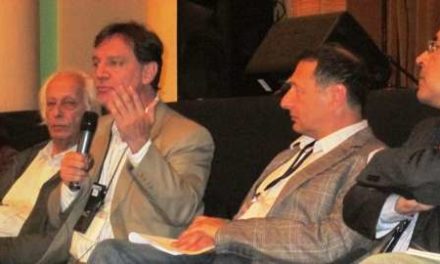Paper Presented at Asian Regional Exchange for New Alternatives (ARENA) Roundtable on,
“War and peace, despair and hope: Re-Positioning Asian Intellectuals After 9-11”
Kowloon, Hong Kong, SAR, May 8-9, 2002
I am grateful to ARENA for the opportunity to participate and learn from you in this conference. These are unusually challenging and dangerous times, and while I have some good news and some bad news to share, I am afraid that it is the latter which will be the focus of my remarks.
Has the world been changed by the September 11 attacks or the Bush Administration’s global crusade? The obvious answer, as the Greek philosopher Heraclitus told us roughly two thousand years ago, is no and yes. A person cannot step in the same river twice. Change is the constant, even as there is continuity within change. In my few minutes I want to point to several dimensions of continuity and of radical change in what can be described as the era of post-Cold War U.S. empire.
Condoleezza Rice, President Bush’s National Security Advisor, tells us that this period is analogous to the years 1945- 47, when Washington with Stalin’s help, created the Cold War.1 The creation of this new imperial disorder involves a disciplining and restructuring of alliances, war – overt and covert – on a global basis that we are told will not end during our lifetimes, massive increases in U.S. military spending, and the militarization, mobilization, and disciplining of U.S. society and political culture.
Beneath the very real facade of the Cold War another dynamic was at play: continued expansion of the U.S. overseas empire that was launched with the conquests of the Philippines, Guam, Cuba and Puerto Rico in 1898. George Kennan, the author of the Cold War containment doctrine, put it well when, as President Truman’s Director of Policy Planning at the State Department in 1948, he advised that
“We have about 50 percent of the world’s wealth, but only 6.3% of its population. In this situation, we cannot fail to be the object of envy and resentment. Our real task in the coming period is to devise a pattern of relationships which will permit us to maintain this position of disparity… The day is not far off when we are going to have to deal in straight power concepts.”2
This, three years after the atomic bombings of Hiroshima and Nagasaki.
Fifty years later, after Japanese and European reconstruction, Bill Clinton put it a little differently: “We have four percent of the world’s population and we want to keep 22% of the world’s wealth.”3
The current crisis also has parallels to what Senator William Fulbright, then Chairman of the Senate Foreign Relations Committee described as “the arrogance of power” in 1966 as President Lyndon Johnson was escalating the genocidal war against Vietnam.4 Fulbright explained that “power tends to confuse itself with virtue and a great nation is peculiarly susceptible to the idea that its power is a sign of God’s favor.” He warned that the United States “may be drifting into commitments which…exceed even America’s great capacities…” At the psychological level, he pointed to the “need that nations seem to have to prove that they are bigger, better, or stronger than other nations” and stressed that “Implicit in this drive is the assumption…that force is the ultimate proof of superiority – that when a nation shows that it has the stronger army, it is also proving that it has better people, better institutions, better principles, and, in general, a better civilization.” While this may not apply to all nations, it certainly describes many of the roots of U.S. “manifest destiny” imperialism.
One other major continuity must be noted: over the longer term, Washington sees China, not Al Queda or Islamic fundamentalism, as its primary strategic concern. Since the Reagan Administration’s “Discriminate Deterrent” doctrine, a priority of U.S. strategic doctrine has been to prevent the emergence of a global or regional rival. This applies to the European Union, Japan, Iraq and Iran, as well as to China. While the Bush Administration may place a greater emphasis on military containment than did the Clinton Administration, both have viewed China as a rising economic, military, and diplomatic power with the potential of becoming a powerful rival and threat. For this reason, both have given priority to integrating China into the U.S.-Japanese-European dominated system by means of military containment and multi-faceted engagement. The goal of containing and intimidating China, not non-existent missile threats from “rogue” nations and the “Axis of Evil”, is the driving force behind the Bush Administration race to develop so-called ” Missile Defenses” and to deploy them around China’s periphery and in space, despite the probability that this will spark a dangerous new arms race in Northeast Asia.
Seeking to kill two birds with one stone, Bush’s “War on Terrorism” in Southeast Asia is more than it appears to be. In addition, in some cases, to the justifiable pursuit of Al Qaeda-related Islamicists, the Bush Administration’s crusade is providing the impetus to “diversify” deployments of U.S. military forces across the region as a RAND study recommended when the Bush Administration first came to power.5 Consistent with those recommendations, Washington and the Macapagal-Arroyo government are exploiting the much diminished capacities of Abu Sayyaf bandits as a rational for training and long term deployments of U.S. forces near the strategically important sea lanes and resources of the South China Sea. Further south, containing Al-Qaida is the rationale for the Pentagon’s reengagement with and support for the Indonesian military. And all of this, along with the new bases in Central Asia and the incipient alliance with India. contribute to the military encirclement of China.
There are, of course, other continuities: repression of secular nationalism leading occupied and besieged peoples to rely on religious values, traditional cultures, and to resort to terrorism as means of resistance; Washington’s commitment to ensure that neither its enemies nor its allies gain independent access to Middle East oil (which even with Central Asian oil beginning to come on line, remains the jugular vein of global capitalism); Washington’s continued reliance on threats of first strike nuclear attack; the Pentagon’s “Full Spectrum Dominance” doctrine and the willingness to sacrifice other nations’ civilians – as we see in Afghanistan – as “collateral damage”; the strategic priority being given to Asia that has been codified in the Pentagon’s Quadrennial Review; and, finally, assaults inside the U.S. on constitutionally guaranteed civil liberties in ways that are reminiscent of the Palmer raids, McCarthyism, and the 1940s internment of U.S. citizens of Japanese descent.
If the river remains, what about it has changed? While the U.S. has visited incomparable death and destruction on other nations during our life times, the losses, shock, and vulnerability resulting from the attacks on the World Trade Center and the Pentagon have led to a national identity crisis in the U.S. For the first time in nearly 200 years, we have suffered a significant attack on our national territory (Hawaii was a colony, not a state at the time of the Japanese attack on Pearl Harbor.) During the Cold War we knew that the oceans were not vast enough to protect us from missile attacks, but now, for the first time in 200 years, we actually suffered deadly attacks from across the seas by men who are committed to “the destruction of the United States.”6
Since September 11, the Bush Administration has acted not only out of political expediency, but to push through its staggering pre-9-11 military and foreign policy agenda. The goal, as our national C.E.O. Dick Cheney described last spring, is to create “the arrangement [for] the twenty-first century” in order to assure that “the United States will continue to be the dominant political, economic and military power in the world.”7 Stephen Hadley, one of Condoleezza Rice’s senior deputies reports that, not unlike the elder Bush’s New World Order, this Bush Administration seeks “a whole new world”, U.S. global domination based ultimately on its nuclear and high-tech arsenals.8
No strangers to the exercise of power, (many in this Administration are retreads from the earlier Bush and Reagan Administrations, and in the case of Rumsfeld, the Nixon era) the Bush Administration harnessed the sympathy, fear, disorientation, and anger that followed the 9-11 attacks to, as Colin Powell put it, “set the reset button” on U.S. foreign and military policies. The post 9-11 trauma and government and media inspired “United We Stand” patriotism have provided the Bush Administration the political and diplomatic cover to withdraw from the ABM Treaty, to increase the U.S. military budget to $400 billion – more than the world’s 25 next largest military spenders – combined! It has also allowed the Administration to breach the Vietnam Syndrome, to renew discredited alliances and create new ones with corrupt and repressive regimes from Indonesia to Uzbekistan, to consolidate what were incipient alliances with Russia and India, and to expand the global network of U.S. foreign military bases – especially in oil and gas-rich Central Asia.
Attention has been focused on the Bush Doctrine that the world’s nations must either support the United States or become its enemy is being used to discipline the world’s governments and to restructure the global (dis)order for the anticipated era of empire. (An interesting new phenomenon is the increasingly common reference to the U.S. as an empire or its policies as imperial in Establishment journals and the mainstream press.) Yet, a more dangerous doctrine “as broad as Kennan’s containment” is also being developed by Richard Haas, the current State Department Director of Policy Planning. Tentatively named “the limits of sovereignty”, the new doctrine affirms U.S. unilateralism in ways that profoundly subvert the United Nations Charter and international law. It would allow nations (read: the United States) to intervene when other nations massacre their own people. (While designed to legitimate U.S. interventions into Iraq or North Korea, by extension of its illogic, it would also theoretically permit other nations to invade the United States to overthrow a regime responsible for imprisoning two million of its citizens and for endangering much of its population with radioactive fallout from the nuclear weapons production and testing cycle.) Haas’ doctrine also creates a new right of “preventive or preemptory, self-defense” for occasions when “its a question of when, and not if, you’re going to be attacked.” Were this doctrine to be universalized, it would legitimate the Japanese attack on Pearl Harbor or given President Bush’s military threats against the “axis of evil,” it would authorize Iraqi, Iranian, or North Korean attacks against the U.S.
A new phenomenon, which preceded September 11 is European concern over U.S. arrogance and military unilateralism, a concern that has led to repeated warnings of a possible schism between the U.S. and Europe. Last summer a senior European diplomat told me that the United States had too much power, something that reminded him of Germany in the 1930s.9 More recently, the British scholar Timothy Garton Ash wrote in the New York Times that he is “worried about” the U.S. “role in the world…that America today has too much power for anyone’s good, including its own. It has that matchless, global soft power in all of our heads. In economic power its only rival is the European Union. In military power it has no rival….Not since Rome has a single power enjoyed such superiority – but the Roman colossus only bestrode one part of the world.10
In fact, Cheney, Rumsfeld, Wolfowitz and their colleagues are modeling themselves after Prussian militarists11 and the 19th century U.S. leaders who charted the U.S. path to global empire by replacing Britain as the master of the high seas. This time the goal is to reinforce the Pentagon’s “Full Spectrum Dominance” doctrine with new generations of high-tech and nuclear weapons and by monopolizing the militarization of space to “control” space to “dominate” earth with the goal of guaranteeing that the U.S. has the “military capability to act at any time, anywhere, in defense of what it sees as its global interests.” As Rumsfeld sees it, 21st century wars will require drawing on “all elements of [U.S.] national power, may be preemptive, will be fought with the (nuclear) U.,S. using “every means at our disposal”, and will include “help from any country,” in a kaleidoscope of changing coalitions.12
Another new element is the Bush Administration’s “infatuation with nuclear weapons.”13 Here, too, there is continuity as well as change. The U.S. now goes to war so often, that there are discernible patterns in the routine of U.S. warfighting. One is that as it prepares to initiate war, the U.S. threatens nuclear attack to ensure that those it is targeting will not be tempted to resort to chemical or biological weapons. Just as Bush the elder threatened Iraq with nuclear attack before the 1991 war, this Bush Administration communicated similar threats to Al Queda and the Taliban.14 This approach has since been reified in the Bush Administration’s Nuclear Posture Review.
As the Natural Resources Defense Council reported “Not since the resurgence of the Cold War in Ronald Reagan’s first term has there been such an emphasis on nuclear weapons in U.S. defense strategy.” The Bush Administrations NPR “assumes that nuclear weapons will be part of U.S. military forces for the next 50 years” and “is planning…programs to sustain and modernize the existing force…” Further, the announced reductions in the size of the U.S. nuclear arsenal being negotiated with Russia are a sham. Yes, the Administration is planning to honor the START II Treaty and a new agreement with Russia to reduce the number of “operationally deployed” nuclear weapons may well be negotiated. BUT, with nuclear weapons that are not “operationally deployed” and those that are stockpiled, “the Bush administration is actually planning to retain the potential to deploy not 1,700 to 2,200 nuclear weapons, but as many as 15,000.”
Of more immediate concern is the Bush Administration’s plan to blur the distinction between nuclear and high-tech weapons, and to more fully integrate the “unthinkable” into U.S. war fighting practice. The Bush Administration’s Nuclear Posture Review calls for a “surge” in the production of new nuclear weapons. The plan is to “design, develop, manufacture and certify new warheads”, some of which will be designed to destroy “Hardened and Deeply Buried Targets”, and “chemical and biological warfare sites.” To facilitate this, the Pentagon is giving top priority to research for inserting existing nuclear warheads into new 5,000 pound bombs – perhaps in time for use against Iraq or North Korea. And, thinking somewhat longer term, the Bush Administration is also planning to reduce the time needed to resume nuclear weapons testing.
I warned you beforehand that I have more bad news than good. As a long-time peace activist recently wrote to me “Keep the faith! We are in for a rough ride!” The good news is that there remain people of conscience in the United States, that a powerful U.S. peace and justice movement, encouraged by peace activists in Europe and Asia and 100,000 people protesting in Washington, D.C. two weeks ago, is coming to life, and that the scale the Bush-Cheney-Rumsfeld global military crusade and its failures are undercutting support for the Administration and its wars.
*Joseph Gerson (PhD)
Director of Programs
American Friends Service Committee
New England Regional Office
2161 Massachusetts Ave., Cambridge, Mass. 02140, U.S.A.
E-mail: [email protected], Phone: 617-661-6130, Fax: 617-354-2832; www.afsc.org/pes.htm
Nicholas Lehmann, “The Next World Order”, The New Yorker, New York, April 1, 2002
James Peck, ed. Noam Chomsky, The Chomsky Reader. New York: Pantheon, 1987, p. 318
“Remarks by the President to AFL:-CIO Biennial Convention,” Pittsburgh, Pa. September 24, 1997.
William J. Fulbright. The Arrogance of Power, New York: Vintage Books, 1966.
Zalmay Khalizad et. al, “The United States and Asia: Toward a New U.S. Strategy and Force Posture:, Rand Corporation, 2001, http//www.rand.org/publications/MAR/MRA1315
Philip Shenon, Terror Suspect Says He Want U.S. Destroyed”, New York Times, April 23, 2002
Nicholas Lehmann. “the Quiet Man”, The New Yorker, May 2, 2001
Lehmann, April 1, 2002, Op. Cit.
Markku Heiskanen, Deputy Policy Planning Director of the Finnish Ministry for Foreign Affairs, April 13, 2001, Seoul, Korea
Timothy Garton Ash. “The Peril of Too Much Power”, New York Times, April 9, 2002
Donald Rumsfeld “Tomorrow’s Armed Forces” Foreign Affairs, May/June 2002. Interestingly, Rumsfeld draws inspiration from not only on Fredrick the Great and Clauswitz, but from the offensive traditions of the German Blitzkreig.
Ibid.; Vision For 2020″ US Space Command, www.spacecom.af.mil/usspace
Natural Resources Defense Council. “Faking Nuclear Restraint: The Bush Administration’s Secret Plan For Strengthening U.S. Nuclear Forces”, February 13, 2002, http://www.nrdc.org/media/pressreleases/020213a.asp
Dana Milbank. “An Implied Threat?” Washington Post National Weekly Edition, October 15-21, 2001. See also, Joseph Gerson. With Hiroshima Eyes: Atomic War, Nuclear Extortion, and Moral Imagination. Philadelphia: New Society Publishers, 1995.








